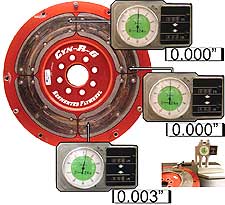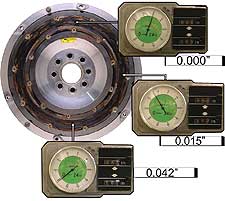| 
RPS Performance Products has attacked these problems head
on and created a patented solution. By segmenting the flywheel
friction surface into four pucks, each puck can expand and
contract in its own CNC machined pocket without affecting
the other pucks. The steel pucks, unlike the one-piece hoop,
have some room to grow.

Even though this RPS Cyn-R-G flywheel
had obviously seen some heavy action, flatness measurements
were still within specification.
|

This aluminum flywheel with a
one-piece heat shield had seen some action, yet measurements
showed the surface beyond specified limits. Look closely.
The six-puck disc became so hot it fused to the heat shield
in six spots. Tip: keep the clutch pedal depressed after
a hot run. |
Because the flywheel surface stays flatter it stays cooler,
and this coolness helps the entire clutch last longer and
perform more consistently. The steel pucks can be replaced
for about the price of a flywheel resurfacing and RPS has
even carried though the segmented design to their Pro MAX
series pressure plates. Why replace the entire flywheel or
pressure plate when the friction surface is the only thing
that's worn?
HARD CORE
As it turns out being able to replace the flywheel and pressure
plate friction surface is a good idea, as the problem of flywheel
hot spots runs deep. RPS had one client with a mysterious
clutch problem. In replacing strip and street-strip stock
Mustang clutches with high performance setups, roughly half
of the customers noted that their clutches chattered on engagement,
despite the fact the flywheels were resurfaced according to
specification.
RPS president Rob Smith mulled over the problem and asked
the technician one question. Out of the customers that experience
chatter how many are running with new flywheels? The answer
was none. Rob managed to get one of the chattering flywheels
in question back to Los Angeles for testing on a Rockwell
hardness measuring device, and the results solved the mystery.
Even though the machining was spot on perfect, the flywheel
cast iron was harder in some spots than others. Excessive
heat had created a flywheel with material of different densities
despite being machined perfectly flat - the hot spots had
gone deeper than could be machined away.
The result was that the clutch disc matrix grabbed the flywheel
quicker in some spots than others and created chatter on engagement.
The only solution in these cases was to start over and use
a new flywheel – an expensive proposition at best. With
a replaceable friction surface new flywheel performance can
be attained for the cost of a stock flywheel resurfacing.
THE MATRIX
The matrix in this case has nothing to do with sci-fi, but
instead refers to the collection of materials, resins, modifiers,
fabric, and other top secret stuff that comprise the clutch
disc friction material as a whole. How these friction materials
grip to flywheel surfaces is part of the formula for clamping
force. The clutch disc matrix literally plows into the microscopic
texture of the flywheel and pressure plate surface and locks
up to create grip. Think about trying to walk with a set of
socks on a hard wood floor. Slip and slide guaranteed. Those
same socks on carpet? Grip city and you're the Mayor.
These same ideas apply to clutch discs and how well they
grip flywheel material. Chromoly, for instance, can be made
into a flywheel that's thinner and lighter, but has drawbacks,
as the material is also a lot harder. This hardness means
it's smooth on a microscopic level, and requires more friction
to create the same grip as cast iron or steel. The paradox
is that the flywheel friction surface has to stand up to serious
punishment, but also has to be made of the softest material
possible in order to grab the clutch disc matrix.
"Let's say you have a six puck with a chromoly flywheel,
vs. an organic with a cast iron flywheel, it's quite possible
the organic with the cast iron will hold more than the six
puck with the chromoly because the chromoly is particularly
hard. You can't just jump off and say the six puck hands down
holds more," said Rob.
Thus the flywheel material has a great influence on the overall
holding capacity of a given clutch setup.

|
